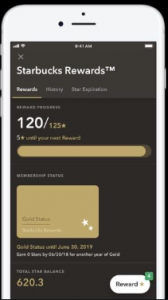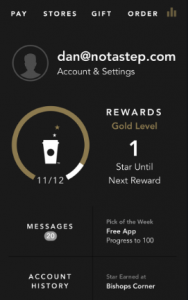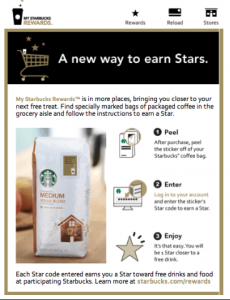
Goal Gradient Effect
First reported by Hull (1934)[1], the Goal Gradient Effect states that the tendency to approach a goal increases with proximity to the goal. Hull found that rats in a straight alley ran progressively faster as they proceeded from the starting box to food.
Kivetz et al (2006) [2] demonstrated the presence of this phenomenon in loyalty programs. They utilised a coffee card reward program experiment to measure the effect on consumers, and reported that members of the program were prone to purchase coffee more frequently the closer they were to earning a free coffee.
The same phenomenon can be observed in loyalty program status points earn, where members have been seen to increase their consumption (more flights, more stays, more rentals) as they approach the next status tier in order to achieve it sooner (so called ‘status runs’ or mileage runs’).[3] Loyalty programs have been observed to capitalise on this insight by promoting bonus status points or miles offers to members as they approach a tier threshold in order to stimulate a boost in discretionary purchase behaviour.
Dollard and Miller (1950)[4] built on Hull’s research, identifying gradients of approach (which become steeper the nearer the desired object) and gradients of avoidance (where the tendency to avoid a feared stimulus is stronger the nearer the subject is to it). The found that the gradient of avoidance is steeper than that of approach, indicating the fear of avoiding something is greater than the desire to obtain something. This may help explain the effectiveness of status tier programs in generating member stickiness.
Drèze & Nunes (2011)[5] used data from a major frequent-flier program to demonstrate that success in achieving a goal contributes to an increase in effort by the member in consecutive attempts to reach the next goal. They replicate the effects in a laboratory study that showed that the impact of success is significant only when the goal is challenging. Importantly, they identified that progress enhanced perceptions of self-efficacy, with successful completion of the tasks providing an added boost.
Gutt et al (2020)[6] built on this research by exploring whether this phenomenon of self-efficacy associated with goal progression extended to status tiers. They found evidence to suggest that members increase their base level of effort after achieving a tier as long as the difficulty of obtaining a tier kept increasing. If the difficult to reach the next tier was lower than or equal to the previous level, members were observed to hold their base level of effort constant. This indicated the existence of a positive effect of tier achievement on subsequent member contribution levels through increased self-efficacy, but only as long as the achievement of tiers remained challenging.
My favourite programs harnessing the Goal Gradient Effect:
- Starbucks Rewards
Within all country specific variations of the Starbucks app, they use a combination of visual progress communication (how far a member has come) together with Goal Gradient communication (how far the member has to go), to motivate members to increase their frequency and recency to unlock more rewards. i.e. ‘1 Star Until Next Reward’.
Starbucks customers are told that they ‘could have earned stars’ on a purchase through receipt messaging and through stickers which are placed on other qualifying Starbucks products (such as packaged coffee, pods, syrups, sauces, cookies ect) which can also be bought at petrol stations and grocery stores. This capitalises on the Goal Gradient effect by driving sign-ups and engagement from customers who do not want their stars (progress) to be wasted.


2. IHG Rewards Club
The IHG Rewards Club is the hotel loyalty program of The Intercontinental Hotel Group (IHG). Members earn points which can be redeemed during stays at more than 4,600 of their hotels and resorts globally, on merchandise or experiences from partners, for frequent flyer points from over 40 airline partners or for car rentals ect.
Alongside points, IHG Rewards Club also has 4 membership tiers which unlock valuable benefits based on nights stayed as members move from Club (base level with 10 points for every $1 spent plus late checkout, free newspaper and free wifi) to Gold (Club benefits plus additional 10% bonus on base earn and priority check in) to Platinum (Gold benefits plus additional 50% bonus on base earn, rollover nights to help maintain status, guaranteed room availability and complimentary room upgrades) to Spire Elite (Platinum benefits plus additional 100% bonus on base earn and a choice of either a 25,000 annual points bonus or gift Platinum to a family member or friend).
Despite the need for a member to make further transactions, the progress tracker enables communications to be framed as a gain (e.g. 1 more stay is required to unlock Platinum benefits) rather than a loss (e.g. $300 spend is required to unlock Platinum benefits). Since the member has started accumulating points and status credits with IHG, switching to a competitor hotel implies losing the progress gained with IHG, reinforcing the Goal Gradient Effect.
Successfully tapping into the Goal Gradient Effect though communicating progress accumulated (via progress trackers and other forms of messaging) together with progress required to get to a specific reward, provides members with a sense of momentum and motivation to unlock a reward the closer they are to achieving it. This motivation can result in an increase in frequency/recency/spend, member stickiness and revenue growth.
[1] Hull, C.l, 1934, ‘The rats’ speed of locomotion gradient in approach to food’, Journal of comparative psychology, Vol 17, pp393-422.
[2] Kivetz, R., Urminsky, O., & Zheng, Y., 2006, ‘The Goal-Gradient Hypothesis Resurrected: Purchase Acceleration, Illusionary Goal Progress, and Customer Retention’, Journal of Marketing Research, Vol 43, pp39-58.
[3] Graham, M, 2018, ‘Five Qantas Status Runs’, The Australian Frequent Flyer, https://www.australianfrequentflyer.com.au/qantas-status-runs/, accessed 9 April 2019.
[4] Dollard, J., & Miller, N. E., 1950, ‘Personality and psychotherapy; an analysis in terms of learning, thinking, and culture’, McGraw-Hill.
[5] Drèze, X & Nunes,J.,2011. ‘Recurring Goals and Learning: The Impact of Successful Reward Attainment on Purchase Behavior.’ Journal of Marketing Research. 48. 268-281
[6] Gutt, D., Rechenberg, T.V., & Kundisch, D. 2018. ‘Goal Achievement, Subsequent User Effort and the Moderating Role of Goal Difficulty’. Journal of Business Research, 106, 277-287.


